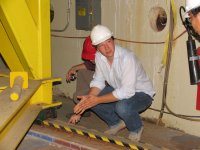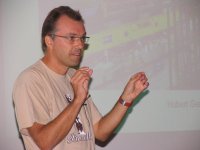 |
 |
|||||||||||||
|
|||||||||||||
|
|||||||||||||
|
Be it a house renovation or even a proposed particle accelerator, anyone involved in a construction project can appreciate the 1948 classic film Mr. Blandings Builds His Dream House, starring Cary Grant and Myrna Loy. In a memorable scene, the married couple meets with their architect, who presents them with the plans for their home. Mr. and Mrs. Blandings proceed to mark up the plans until they are no longer recognisable, turning the mere home into their dream home. Sure, there is the minor detail of the chimney going through the middle of Mrs. Blanding's sewing room, but that is the architect's problem to figure out, right? As opposed to the Mr. and Mrs. Blandings method of taking the design of their dream house into their own hands, the ILC engineers, accelerator and detector physicists are already engaging in a dialogue (hopefully one that will prevent a chimney going through the middle of a detector). Roughly one hundred members from the ILC engineering, accelerator and detector communities started swapping information at the IRENG07 workshop that took place at SLAC in mid-September. Even though the proposed construction start for the ILC is still years away, a detailed schematic for the underground detector cavern should be prepared now, as part of the engineering design phase for the project. The engineers need to know such things as the detector dimensions and the weight of the heaviest components to determine how many and what types of cranes will be needed. The detector concept groups need to provide the answers, which isn't exactly easy as they are still defining their engineering designs too. The accelerator physicists need to make sure that the design of the hall and the detectors won't have impacts on delivering the highest quality beam. All the different requirements can be overwhelming for any person involved in the project, but the participants at IRENG07 have the comfort of knowing that they are all ultimately working toward the same goal - scientific discoveries. Building the cavern is only one piece of the puzzle though. During the workshop, detector and accelerator physicists and engineers started working through the details for the technical systems related to the interaction region in the ILC. From the superconducting magnets to alignment to detector mechanics, IRENG07 gave the different technical system groups the opportunity to start figuring out how to connect all of the pieces. SLAC's John Weisend II, for example, outlined the requirements for the cryogenic system in the detector hall. He explained that the goal is to be able to move the detectors while they are cold. It would also be ideal for the detector that is not in use to have the option of being cold and powered. Keeping the detectors cold will have an impact on their design, the location of equipment both in the detector hall and on the surface, and safety requirements….just to name a few. Taking these kinds of requirements into consideration now could have a big impact down the road, especially when every minute of data-collecting time and shutdown time will be precious. But before the detectors would actually start operating, the engineers and physicists must first determine how to safely lower the detector components down a shaft, 100 metres underground. Learning from past experiences always helps, which is why Hubert Gerwig attended the IRENG07 workshop. As an engineer in charge of moving the CMS experiment at CERN underground, Gerwig had plenty of stories to share. “If you're in a physics department, you are surrounded by a lot of analytical thinking,” he said. “This goes to a certain point, but when you take over their $200 million baby and want to lower it underground, things become a little more emotional.” Gerwig recalled the last meetings with the CERN physicists before they started lowering the detector and some of the questions on the "parents" minds. Will it sway like a Foucault pendulum? If the system gets excited, what will the force be? What if the frequency of the cables is the same and the whole system gets in resonance? What would happen if there is an earthquake? “When you lower down millions of dollars, you shouldn't fail,” he said. Discussions are good, Gerwig explains, but it is best to do a test. So before they lowered CMS, the design office created a dummy load with 350 tonnes of dead weight from scrap metal and iron blocks. They also prepared several computer simulations that helped them discover one potential problem just one day before the scheduled lowering. “We noticed that a foam blower for fire extinguishing had been installed at exactly the wrong place where we wanted to pass,” Gerwig said. Problem solved - remove the foam blower. To answer the questions though, Gerwig explained that the cables do not sway and resonancy is not an issue. Several safety precautions are also taken during the early design phases should an earthquake or fire occur. Experts from CERN will continue to play a large role in the design of the detector cavern and shafts, and this first IRENG07 workshop is really just the beginning. Workshop organiser Andrei Seryi explained that an interface document will be published to address all of the outstanding questions. Seryi hopes that this document will be a step toward developing the more formal documents necessary during the engineering design phase. “It is most important to keep working together,” he said. “We have a unique collaboration of experts together, and we would like to keep this group connected.” That way, in the end, the project should have its dream house. -- Elizabeth Clements |
|||||||||||||
| © International Linear Collider |


